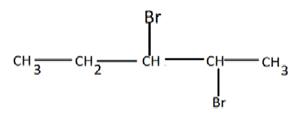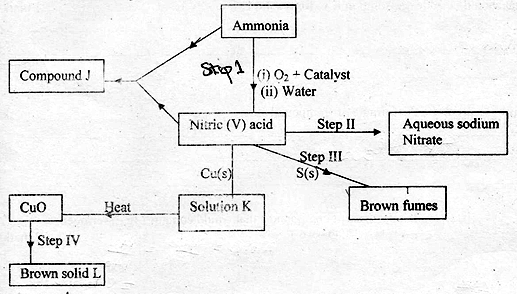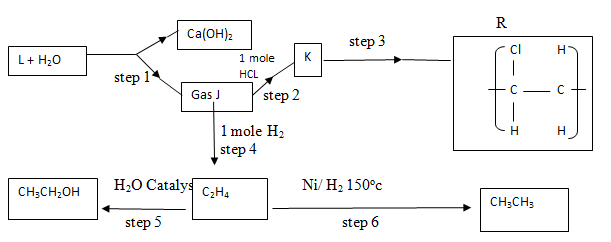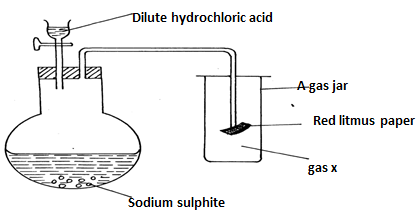INSTRUCTIONS TO CANDIDATES
- Answer all the questions in the spaces provided above.
- KNEC Mathematical tables and Silent electronic calculators may be used.
- All working must be clearly shown where necessary.
- Candidates should answer the questions in English.

QUESTIONS
- A compound D of molar mass 42 was found to have the following composition by mass. Carbon = 85.7 %, and the rest hydrogen. (C=12, H=1)
- Find the molecular formula of the compound. (3mks)
- Draw the structural formula of compound D (1mk)
- Name the homologous series to which compound D belongs. (1mk)
- About 5cm3 of compound D was bubbled into a boiling tube containing hydrogen bromide. The mixture was shaken and then allowed to stand for about 2 hours. A new compound K was formed. Name and draw the structural formula of compound K. (2mks)
- Give two functions of compounds to which compound D belongs. (2mks)
- A compound X reacts with bromine to form another compound W whose structural formula is as follows: -
- Name compound X and W (1mk)
X…………………………………………………………
W………………………………………………………… - What observation is made in this reaction? (1mk)
- Write a balanced equation for the reaction between X and bromine (1mk)
- Name compound X and W (1mk)
-
- The scheme below shows various reactions starting with ammonia. Study it and answer the questions that follow.
- Name the raw materials used in the manufacture of ammonia. ( 2 mks )
- Name a catalyst that is used in step I ? ( 1 mk )
- Write an equation for the reaction that occurs between ammonia and nitric (V) acid ( 1 mk )
- Identify the process in step II ( 1 mk )
- State the condition necessary for the reaction in step III to occur. ( 1 mk )
- Name solution K ( 1 mk )
- Write the formula of solid L. ( 1 mk )
- Calculate the mass of solid L that would be formed by using 12 dm3 of hydrogen at room temperature in step IV (Molar gas volume at r.t.p. = 24 dm3, R.A.M of L = 63.5) ( 3mks)
-
- Identify the brown fumes in Step III. (1mk)
- State the property of nitric(V) acid demonstrated by the reaction in Step III above. (1mk)
- The scheme below shows various reactions starting with ammonia. Study it and answer the questions that follow.
- A form three student was provided with the following reagents:
- Solid L; containing 5.0g per litre of a dibasic organic acid H2X.2H2O.
- Solution M; which is acidified Potassium manganate(VII)
He was required to standardize solution M using solution L.
A burette was filled with solution M and 25.0 cm3of solution L was pipetted into a conical flask. It was then heated to about 70oC, the hot solution L was titrated with solution M while shaking the flask thoroughly until a permanent pink colour just appeared. The procedure was repeated two more times and the results entered in table 1 below.
Table 1
1 2 3 Final burette reading (cm3) 24.4 34.8 44.7 Initial burette reading (cm3) 0.0 10.0 20.0 Volume of M used (cm3) - Complete the table. (3mks)
- Calculate the average volume of solution L used. (1mk)
- Given that the concentration of the dibasic acid is 0.05M, determine the value of X in the formula H2X.2H2O (H=1.0,O=16.0) (2mks)
- Calculate the number of moles of the dibasic acid H2X.2H2O used. (1mk)
- Given the mole ratio manganate(VII)(MnO4-): acid H2X is 2:5, calculate the number of moles of manganate(VII) (MnO4-) in the average titre. (2mks)
- Calculate the concentration of the manganate(VII), (MnO4-) in moles per litre. (2mks)
- Dry hydrogen chloride gas was passed through heated iron wire as shown in the diagram below
-
- How can the identity of the substance burning with flame Z be confirmed. (1mk)
- What is observed in combustion tube during the experiment? (1mk)
- Write the equation for the reaction taking place in the combustion tube. (1mk)
- Chlorine gas was passed over the product obtained in the combustion tube to give another product Q
- State one precaution that should be taken. Explain (2marks)
- Identify product Q (1mark)
- The total mass of product Q formed was found to be 5.3g. Calculate the volume of chlorine gas used.(Cl = 35.5, Fe= 56, Molar gas volume at room temperature = 24000cm3 (3marks)
- Chlorine bleaches by oxidation while Sulphur (IV)oxide does so by reduction. Explain. (2 mks)
-
-
- What name is given to a compound that contains carbon and hydrogen only? (1mk)
- Hexane is a compound containing carbon and hydrogen.
- What method is used to obtain hexane from crude oil? (1 mk)
- State one use of hexane. (1 mk)
- Study the flow chart below and answer the questions that follow.
- Identify reagent L (1 mk)
- Name the catalyst used in step 5. (1 mk)
- Draw the structural formula of J (1 mk)
- What name is given to the process that takes place in step 5? (1 mk)
- State;
- One use of product R (1 mk)
- A commercial application of the process which takes in step 6. (1 mk)
- 30cm3 of ethene gas was exploded with 100cm3 of oxygen gas.
Determine the volume of carbon(IV)oxide gas generated. (2mks)
- Study the periodic grid below and answer the questions which follow. The letters do not represent actual symbols of the elements.
- To which category of elements does element N belong? (1mk)
- Compare the atomic radius of element E and U. Explain. (2mks)
- An ion A3− has a configuration of 2.8. Place element A on the grid above. (1mk)
- Which of the group 1 elements will require the greatest amount of energy to remove the outermost electron. Explain. (2mks)
- Why is element Z used in light bulbs? (1mk)
- Write the formula of the phosphate of element T. (1mk)
- State the type of bond and structure found in the oxide of element Q (2 mks)
- Select from the grid:
The most electropositive element ……………….. (1mk)
The most electronegative element ……………….. (1mk)
- In the preparation of magnesium carbonate, magnesium was burnt in air and the product collected. Dilute sulphuric acid was added and the mixture filtered and cooled. Sodium carbonate was added to the filtrate and the content filtered. The residue was washed and dried to give a white powder.
- Give the chemical name of the product formed when magnesium burns in air (1mk)
- Write a chemical equation for the formation of product in (a) above. (1mk)
- Name filtrate collected after sodium carbonate was added (1mk)
- Write a chemical equation for the reaction between product in (a) and acid. (1mk)
- Write an ionic equation to show the formation of the white powder (1mk)
- Write an equation to show what happened when white powder is strongly heated. (1mk)
- Study the set-up below and answer the questions that follow:
- Identify gas X (1mk)
- Write an equation for the reaction that produces gas x. (1mk)
- What is the effect of the gas X above on the red-litmus paper? (1mk
- What observation is made when gas X is bubbled through lead(ii)nitrate solution. Explain. (2 marks)

MARKING SCHEME
-
C H % composition
Moles ✓½
Mole ratio ✓½
85.7
85.7/12
7.142
1
14.3 ✓½
14.3/1
14.3
2
Empirical formula
CH2 ✓½
(12+2)n =42
14n=42
n=3 ✓½
Molecular formula C3H6 ✓½
- Alkenes ✓1
- 2-bromopropane ✓1
- Source of fuel; ✓1
Manufacture of plastics; ✓1
Ripening of fruits any two for 2mks -
- X Pent-2-ene ✓1
W 2,3-dibromo pentane ✓1 - The brown bromine vapor is decolorized. ✓1
- C5H10+Br2 →C5H10Br2 ✓1
- X Pent-2-ene ✓1
-
-
- Nitrogen✓1 ; hydrogen ✓1
- Platinum-rhodium✓1
- NH3(g)+HNO3(aq) →NH4NO3(aq) ✓1
- Neutralization✓1
- The nitric(V) acid must be hot ✓1
- Copper(II)nitrate ✓1
- Cu ✓1
- CuO(s)+H2(g) Cu(s)+H2O(l)✓1
Mol of Hydrogen gas=12/24
=0.5✓½
Ratio of H2:Cu=1:1 ✓½
Mol of Cu=0.5 ✓½
Mass of Cu=0.5 × 63.5
=31.75g ✓½
-
- Nitrogen(IV)Oxide✓1
- Oxidizing agent ✓1
-
-
- 24.4✓1 24.8✓1 24.7✓1
- (24.8+24.7) ✓½
2 =24.75cm3✓½ - Molarity=mass/RFM
0.05 =5.0/RFM ✓ ½
RFM=5.0/0.05 ✓½
=100 ✓½
2+X+2(18)=100
X=62 ✓½ - Mole=(M×Vol)/1000
0.05× 25
1000 ✓½
=0.00125 ✓½ - Mole of MnO4- =(2×0.00125)
5 ✓½
=0.0005 ✓½ - Molarity=mol/vol
0.0005 ×1000
24.75 ✓½
=0.02M ✓½
-
-
- Insert a burning splint/flame✓½ into a gas jar of gas. It will burn with a pop sound✓½.
- Grey iron wire changes to green ✓1
- Fe(s)+HCl(g)FeCl2(s)+H2(g) ✓1
-
- chlorine gas is poisonous✓1, the experiment should be done in the fume chamber/in the open✓1
- Iron(III)Chloride ✓½
- 2FeCl2(s)+Cl2(g)→2FeCl3(s) ✓½
moles of Q=5.3/162.5
= 0.03262✓½
Moles of Chlorine gas reacted= 0.03262x2 volume of chlorine=24000x0.01631
=0.01631✓½ =391.38cm3 ✓½ - Chlorine reacts with water to form HOCl which donates atomic oxygen to the dye√1 oxidizing it, while Sulphur(IV)Oxide forms H2SO3 which absorbs atomic oxygen from the dye√1 hence reducing it.
-
-
- Hydocarbon✓1
-
- Fractional distillation✓1
- Fuels✓1; Source of hydrogen during cracking (any one acceptable for 1mk)
-
- calcium carbide✓1
- Phosphoric(V) acid✓1
- H-C≡C-H✓1
- Hydration✓1
-
- Plastic pipes✓1 ( accpt any other relevant use)
- Hardening oils to form margarine✓1
- C2H4(g) + 3 O2(g) →2 CO2(g) + 2 H2O(g) ✓1 (don’t penalize state symbols)
1V 3V 2V 2V ✓½
30cm3 90cm3 60cm3 ✓½
-
- Transition elements ✓½
- Atomic radius of U is smaller✓1. U has more protons✓1/ has stronger nuclear attraction for outermost electrons/ has a higher nuclear charge.
- Group V period 2, (award mks if only shown on the grid✓1)
- M, has a smaller atomic radius√1, hence outermost electron is strongly✓½ attracted to the nucleus. A lot of energy is required to remove this electron✓½.
- It is chemically inert.
- T3(PO4)2✓1
- covalent bond✓1, molecular structure✓1.
- S✓1
X✓1
-
- Magnesium oxide✓1
- 2Mg(s)+O2(g)⟶2gO(s) ✓1
- Sodium sulphate✓1
- MgO(s)+H2SO4(aq)⟶MgSO4(aq)+H2O(l) ✓1
- Mg2+(aq) +CO32-(aq)⟶MgCO3(s) ✓1
- MgCO3(s)⟶MgO(s)+ CO2(g) ✓1
-
- Sulphur (iv)oxide✓1
- Na2SO3(s)+2HCl(aq)⟶2NaCl(aq)+SO2(g)+H2O(l) ✓1
- The red litmus paper changes to white ( is bleached) ✓1
- White precipitate√1.Due to the formation of insoluble lead(ii) sulphite. ✓½
Download Chemistry Paper 2 Questions and Answers - Form 3 Term 3 Opener Exams 2021.
Tap Here to Download for 50/-
Get on WhatsApp for 50/-
Why download?
- ✔ To read offline at any time.
- ✔ To Print at your convenience
- ✔ Share Easily with Friends / Students









